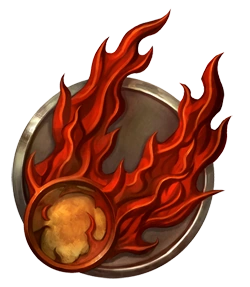
The Twin Tailed Comet, holy symbol of the Cult of Sigmar
Johann Helsturm,[1a][2a][3a] spelled Johann Helstrum in some sources,[4a] was a mendicant friar from Nuln, who later became famous as the first high priest or "Grand Theogonist" of Sigmar in the Empire. He founded the Cult of Sigmar in 73 IC and remained in office until an unknown date.[1a][2a][3a]
History[]
Origins of the Cult of Sigmar[]
Sigmar ruled the Empire of Man he founded for over fifty years. During this time the rough villages of the various barbarian tribes he had united blossomed into small towns, the people multiplied, and many new settlements were founded. Of course there were still enemies to fight: marauding Goblins continued to cross over the Worlds Edge Mountains, and there were plenty of savage Human tribes in the northern forests beyond the Middle Mountains. Of Sigmar's reign very little is known at present, for the Dwarf annals are concerned chiefly with their own affairs and Sigmar's part in them. All that is known for certain is that Sigmar eventually put aside his crown and journeyed eastwards, supposedly to Karaz-a-Karak to meet his old friend Kurgan Ironbeard.[1a]
If he ever arrived at that most famous of all Dwarf holds the Dwarf records do not tell. The time of Sigmar passed, and he became a legend, the heroic forebear of his people. Temples and shrines were built to his memory, and a cult grew up to venerate him as the divine founder of the Empire.[1a]
Within a generation Sigmar was openly worshipped as a god, with his own priesthood headed by a high priest called the "Grand Theogonist" by 73 IC. The first Grand Theogonist was Johann Helsturm, and he became one of the most powerful men in the whole land, with many thousands of loyal followers. Sigmar soon took his place alongside the other chief gods of the Empire: Taal, god of nature and the wilds, Ulric, god of war, winter and wolves and Morr, god of the dead.[1a]
Rise of Sigmarism[]
At the beginning of his journey Johann Helsturm claimed he saw a vision of Sigmar's ascent into the heavens as a god. On the strength of these convictions alone, he preached the new religion to any who would hear him. When he arrived in the city-state of Nuln, Sigmar was already revered as a deity in this even-then cosmopolitan city. The commoners converted to the new Sigmarite faith, establishing small cults in the newer parts of town. Soon after, it became fashionable to buck tradition, and the younger nobles abandoned the old ways in favour of the Imperial symbol-made-god that was Sigmar.[4a]
Encouraged by his successes in his home city, Helstrum next travelled north to Altdorf, where he continued his work to spread the word of this new god. The results were spectacular and soon after, the newborn Cult of Sigmar received recognition as an official state cult of the Empire with the erection of a temple dedicated to Sigmar in Altdorf.[4a]
Back in Nuln, the smaller cells united to build the first temple of Sigmar on the slopes of the hill that hosted the Elector Count's own fortress. Those people who remained loyal to the old ways in which the Cult of Ulric was paramount in the Empire were appalled by the presence of this heretical edifice overshadowing what they saw as the true gods. The city divided between those still loyal to Ulric and the new Sigmarites, and sporadic fighting and riots erupted in the streets.[4a]
In about 100 IC, faced with the growing violence between the rival cults in Altdorf, Emperor Fulk moved the Imperial capital to Nuln in an unexpected show of support for the Sigmarite faith. Since Helstrum, now the first high priest or "Grand Theogonist" of the Cult of Sigmar hailed from this city, it was only fitting the Imperial monarch should move to a place friendlier to his politics.[4a]
Defeated, the few remaining Ulricans left the city for Talabecland where the Ulrican faith was still strong. Unfortunately, the emperor's entourage of sycophants and hangers-on soon filled the vacuum left by the departing Ulrican nobility. What had once been for the most part a frontier city was suddenly thrust into the very centre stage of Imperial politics.[4a]
